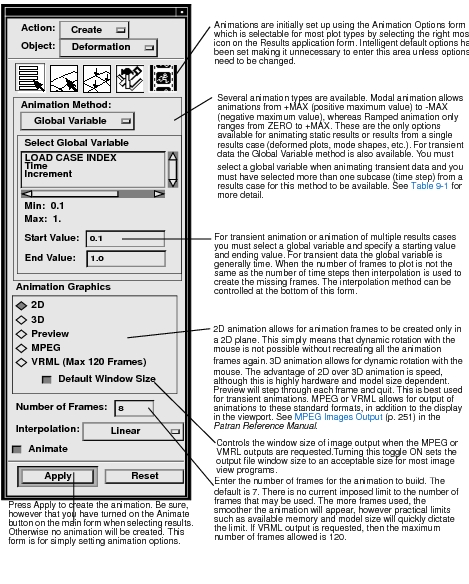XXXXXXXXXXXXXXXXXXXXXXXXXXXXXXXXXXXXXXXXXXXXXXXXXXXXXXXXXXXXXXXXXXXXXXXXXXXXXXXXXXXXXXXXXXXXXXXXXXXXXXXXXXXXXXXXXXXXXXXXXXXXXXXXXXXXXXXXXXXXXXXXXXXXXXXX''"> 9.2 Animation Options
There are two aspects of animation: selecting animation options before animation actually begins, and controlling the animation once plots are animating. This is the most general display of the Animation Options form.

Animation Interpolation
To create the specified number of frames for any animation, the program will do interpolation of the data because in most cases there will not be a one to one correspondence of frames to number of results cases. The default is to use Linear interpolation.
The interpolation method has no effect on the animation of static data (mode shapes, deformed plots). Each frame is determined using a simple harmonic or linear scale factor multiplied by the given static result.
For transient animation this is not the case. The interpolation method is used to determine how results are calculated for frames which do not have exact results present. During transient animation, the selected global variable is scaled linearly from its starting to ending value, evenly progressing between each animation frame. If the Load Case Index is chosen, then a dummy variable is assigned to each specified loadcase (1.0-n) and it is used as the interpolation basis (the independent variable). Once a global variable value is determined from each frame, the result values are then calculated based on the available results specified for the animation.
The following is a table of interpolation methods along with their descriptions:
Action | Description |
Linear | This is the default interpolation function. The results for a given frame are determined using linear interpolation which performs a weighted average of the two closest results cases to the current frame. |
Closest Value | No interpolation is performed. Only results found in the analysis are used. The closest results values associated to the current global variable are used for frame creation. |
None | No interpolation is performed. Only results found in the analysis are used. The None interpolator will simply repeat the last usable data to fill the excess frames. |

